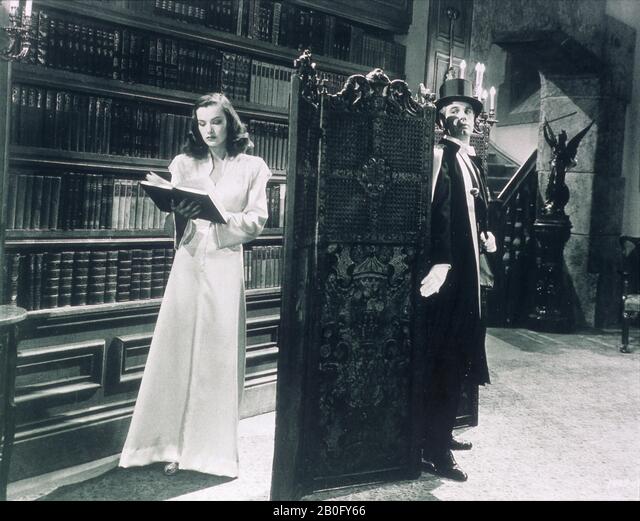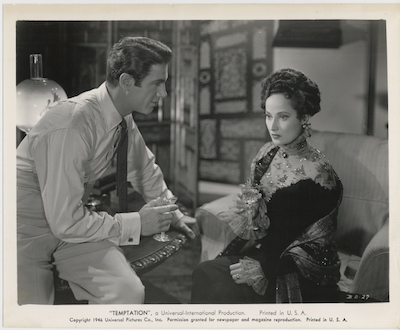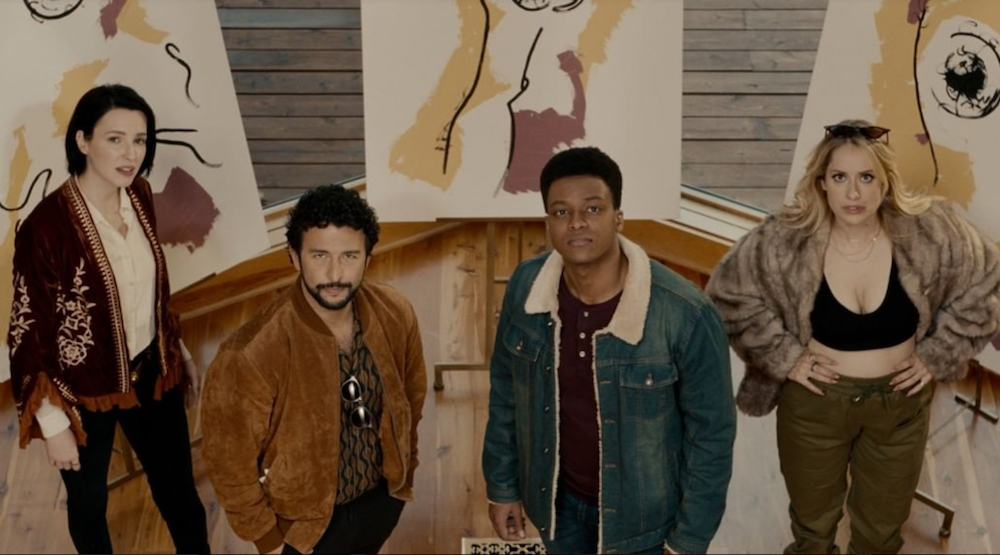« June 2022 | Main | August 2022 »
July 26, 2022
Time Out of Mind

Robert Siodmak - 1947
KL Studio Classics BD Region A
If Time Out of Mind had not been directed by Robert Siodmak, would it still be a film of interest? Maybe for those who love melodramas or stories that take place in the late 19th Century. It is not as if this was a bad film, but there is only a hint of the visual style that has made Siodmak a film noir favorite. As for suspense, there is a little bit in the last reel when the estranged former wife makes plans, never clearly detailed, to sabotage a concert.
The story is about the misfortune of the Fortune family. Christopher Fortune III comes from a line of merchant sea captains, a prominent Maine family. His aspirations for composing music are put aside after being forced by his father to go to sea as a crew member to learn first hand how to handle a ship. After coming home with an apparent brain concussion, Chris' sister, Clarissa, and a family servant, Kate, conspire to have Chris sneak off to Paris to study music composition. Chris and Clarissa return home three years later, with Chris now married to Boston society daughter Dora. Chris has become an alcoholic, with self-doubts about his musical abilities. Kate, always in love with Chris, hopes to get him to still realize his dreams.
There is one interesting shot, the first time Chris is seen playing piano for Kate. The camera is tilted upwards towards the two, who are both straight parallel to the horizontal lines of the frame. But the barred windows in the background are slightly tilted, a less than obvious "dutch" or canted angle. More conspicuous are several point of view shots going in and out of focus, representing Chris' psychological haze.
The film was intended to inaugurate the Hollywood career of British actress Phyllis Calvert. Siodmak and Calvert had expressed interest in working together, which finally happened after a couple of false starts. As it turned out, neither was happy with the other. Calvert's Hollywood career was over within four years. She is seen to better advantage in the British films for Gainsborough, a studio specializing in period films and melodramas, in such films as The Man in Grey and Madonna of the Seven Moons. Calvert appears here as Kate. The film also marks the last of four films Ella Raines made with Siodmak, appearing here as Clarrisa. I do not know what kept him out of serving, but Robert Hutton's stardom primarily lasted through World War II and a few years later, eventually turning to lead roles in smaller films and supporting roles in a few bigger films. It is not that Hutton is miscast as Christopher Fortune, just not particularly memorable.
The commentary track is by film historian Lee Gambin with costume historian Elissa Rose. Gambin primarily covers how the film fits in with filmography of Robert Siodmak, as well as some notes on Phyllis Calvert. Rose covers the costuming by Travis Banton as well as an overview on his career. Rose also talks about some of the musical influences in the score credited to both Miklos Rozsa and Mario Castelnuovo-Tedesco, name checking among others, Charles Ives.
A deeper look at the music, both as part of the narrative, and why the score is credited to two men, would be of interest. Prior to his first American concert, Chris describes his music as imitating Claude Debussy. Although Debussy was not internationally known until at least a decade after Time Out of Mind takes place, it is not a stretch to assume that Chris was aware of him during his time in Paris if one more closely identifies when the film takes place. On the evening of the first concert, an inebriated Chris doodles on a bar's piano, playing "Daisy Bell (A Bicycle Built for Two)". That song was published in 1892. Chris incorporates the then popular song as an improvisation in his concert, which probably inspired the Charles Ives reference as Ives would use short stanzas from well known songs into his own compositions. As for the film score, while Rozsa's name is familiar, Castelnuovo-Tedesco rarely was credited for his own work. Not only did Castelnuovo-Tedesco only receive few credits, but much of his music was frequently recycled as stock music from other films. IMDb also noted that Castelnuovo-Tedesco may have been a ghost writer for other film score composers. As for Chris' concerto, it is a reworking from an earlier Rozsa score for Julien Duvivier's Lydia (1941).
Posted by Peter Nellhaus at 06:22 AM
July 20, 2022
Film Noir - The Dark Side of Cinema VIII

Street of Chance
Jack Hively - 1942

Enter Arsene Lupin
Ford Beebe - 1944

Temptation
Irving Pichel - 1946
KL Studio Classics BD Region A three-disc set
Anybody who has looked at any of the previous Film Noir sets should know by now that not all of the films included may pass the purity test. Of the three film here, only Street of Chance can really be considered film noir, while Temptation has some noir elements. Enter Arsene Lupin is in no way film noir, but it is also the most entertaining of the three here. The directors can be best described as journeymen, with Irving Pichel occasionally having been assigned a few minor A films. The casts here are a mostly assemblage of lower tier leads and some beloved character actors. Perhaps not so coincidentally, all three films have actors whose careers were disrupted by the Hollywood blacklist that began in the late 1940s.
Street of Chance begins in a fictionalized New York City where no one is given notice that there is work being done on the exterior of an otherwise vacant apartment building. Burgess Meredith gets knocked on the head by a very large piece of debris and wakes up with amnesia. Not only is he not sure who he is, but he has no idea why why the intimidating Sheldon Leonard is chasing after him. Even worse is when he finds out he is involved with a murder though he is certain he never killed anyone. The story is from Cornell Woolrich, whose characters usually stumble into situations they can not always get out of. Jack Hively has brief career as a director of modestly budgeted theatrical films before doing some second unit work and assignments on various television series. Stylization comes in the form of several overhead crane shots. Jerome Cowan is on hand to provide some villainy as the heir to a family fortune.
Jason Ney's commentary track includes discussion on the use of amnesia as a film noir plot device, and how the film differs from the novel by Woolrich. Also of interest is the history of how the film was distributed, as a second feature in urban areas, but as a stand alone feature in rural areas where many of the theaters were independently owned and operated and play dates were often two or three days.
Enter Arsene Lupin is hardly film noir but it is a lot of fun. So many versions of the gentleman thief. The most recent version is a French mini-series with the charismatic Omar Sy. In this film, the title role is taken by Charles Korvin, a Hungarian actor who appears to have been Universal's answer to Paul Henreid, the romantic European lover. Ella Raines is the Greek heiress with the emerald coveted by both Lupin and her bankrupt relatives. And my expectations were low coming in on this one because all I knew of director Ford Beebe was his work on a couple of "Flash Gordon" serials. The screenplay was by Bertram Milhauser who wrote several of the Basil Rathbone Sherlock Holmes films, with cinematography by Hal Mohr. So we have solid craftsmanship and some witty banter, aided in no small way by J. Carrol Naish as the flustered French cop chasing Lupin, Gale Sondergaard as Raines' aunt, and George Dolenz (father of a Monkee) as Lupin's partner in crime.
Historian Anthony Slide is engaging in covering the literary and cinematic history of Lupin. An amusing part of his commentary track is pointing out the non-English locations and bad accents of some of the supporting cast. Enter Arsene Lupin reportedly was only seen as a second feature at the time of its release, which got dismissive reviews. Slide briefly digresses into his research on the correct pronunciation of Ford Beebe's last name. Conspicuously, there is no clear identification about when the film takes place, although World War II is neither seen nor heard.
Temptation was the fourth film version of a 1909 novel about romantic intrigue in Egypt in 1900. Unlike the other two films in this collection, it was an A film, albeit produced with a smaller budget by the independent studio, International, just prior to their merger with Universal. This version has noir elements that were not part of the earlier films. Merle Oberon plays a widow of a certain age who decides Egyptologist George Brent will be able to support her in the style to which she is accustomed. While Brent is off on an archaeological expedition, Oberon, bored in her palatial Cairo villa, begins an affair with Egyptian playboy Charles Korvin. There is a plot to murder Brent, and concerns of a curse when a pharaoh's tomb is uncovered. Along for the ride is Paul Lukas as Brent's best friend, a doctor named Meyer Isaacson who makes a joke about his ancestors having built the pyramids, part of the Hollywood tradition of being Jewish without actually stating you are Jewish. Oberon's husband, Lucien Ballard, was the cinematographer, notable as he created special lighting for Oberon to disguise some post-accident facial flaws.
Kelly Robinson's commentary track reviews the history of the source novel as well as the four film versions.
Posted by Peter Nellhaus at 06:31 AM
July 18, 2022
The Silver Screen - Color Me Lavender

Mark Rappaport - 1997
Kino Classics All Regions DVD
There are probably better analogies, but this new DVD with one feature-length work plus three shorter films as a bonus is kind of like having a good, but not totally satisfying dinner at a restaurant where the desserts are all bette than the main course. Color Me Lavender might be viewed as complimentary to Vito Russo's The Celluloid Closet. Rappaport has more on his mind than how gay men are represented on film, with many of his questions valid on how film should be "read". By this I mean historical and cultural contexts at the time of creation, how certain tropes were understood by audiences of the past, as well as what may or may not have been intended by filmmakers of the time. What makes Rappaport's inquiries into cinema history interesting are the various connections he makes, some of them unexpected.
Rappaport limits his survey to films from the Thirties, Forties and Fifties with a slight nudge into the early Sixties, and primarily Hollywood with a brief jaunt into France and Italy. Dan Butler provides the narration and appears on screen walking in on freeze frames of several of the films. Some of material is familiar - the homoeroticism of the onscreen relationship of Dean Martin and Jerry Lewis, the now beaten to death Randolph Scott/Cary Grant stories, how the film Crossfire, praised for addressing anti-Semitism, was based on a novel where the victim was a gay soldier. More amusingly, and possibly to the chagrin of fans and scholars of Westerns, is the presentation of cowboy hero and his older sidekick as coded, with the dynamics of the relationship based on who makes the coffee. I am almost surprised that Rappaport made no jokes about Walter Brennan having two modes of acting - with or without teeth. That very brief foray into the Sixties is in the opening, with Jose Ferrer getting to first base with the shirtless Peter O'Toole in Lawrence of Arabia, a film that could have easily been advertised as starring "an all male cast" and really not be wrong.
Curiously, the only gay filmmakers discussed are Jean Cocteau and Luchino Visconti, and their male muses. For Cocteau, this means how Jean Marais is lit and framed in loving close-ups. For Visconti, it is how Massimo Girotti was filmed in Ossessione. Aside from Alain Delon's photogenic qualities in Rocco and His Brothers, Rappaport looks at the relationship between Rocco and Simone, how the brothers are also linked by the woman they are both in love with as well as the boxing manager they both work for.
The bonus films, three video essays, are tangentially connected to the main feature. The Vanity Tables of Douglas Sirk is about literal and symbolic uses of reflections within the narrative in Sirk's films. Additionally the choice of shots and how multiple characters may appear in the mirror demonstrates Sirk's ability to create several focal points within the camera frame. The Double Life of Paul Henreid is about actor turned director's career trajectory, from top or second lead as a Warner Brothers contract star, to his turn in lower budget fare in independent or foreign films following the blacklisting era. Rappaport connects three film Henreid produced, directed and/or starred in Hallow Triumph, Stolen Face and Dead Ringer with plots involving twin identities. Dead Ringer. Martin und Hans is presentation of clips from films featuring Martin Kosleck and Hans Heinrich von Twardowski, gay German refugees and longtime partners, who had varying degrees of success as supporting players in Hollywood. Rappaport's screenplay is comprised of first person offscreen narration from actors portraying the two men. The lesser known von Twardowski's biggest role was as a gay prisoners in the German silent, Sex in Chains by William Dieterle. The better known Martin Kosleck made a career of playing Nazi officers. At one point, Kosleck suggests to Rappaport that a video essay be made of Kosleck's five times portraying Joseph Goebbels, to which I say, "Yes, please".
Posted by Peter Nellhaus at 06:29 AM
July 05, 2022
The Summoned

Mark Meir - 2022
XYZ Films
The Summoned begins as a psychological horror film during its initial setup. Four people receive invitations to the remote lodge of a celebrity therapist, Dr. Frost. Three of the invitees are successful - entrepreneur Joe Agrippa, the actress Tara, and singer-song writer Lyn. Out of place is Lyn’s boyfriend, Elijah, a car mechanic by trade, but also an aspiring musician. While there is nothing in the screenplay to indicate race, the Elijah is portrayed by a black actor provides an immediate marking of the character as an outsider to the materially successful trio. Dr. Frost’s therapy weekends consist of acknowledging what he calls sins, not specifically in religious terms, but closer to challenges to conventional social attitudes.
Elijah has nightmarish dreams, or could they be premonitions, of his own death or the death of others. One of the recurring images is of Elijah digging a grave. He is constantly kept unbalanced by the suggestion that Lyn is secretly having sex with Joe, with Tara’s attempts at seduction, Dr. Frost’s idiosyncrasies, and the periodic appearance of a what appears to be a mentally unbalanced squatter on Frost’s property. The general narrative outline is admittedly not original. Fans of older horror films could probably name at least a couple of similar films just from memory. Certainly Meir and screenwriter Yuri Baranovsky could well have gone in different directions regarding the relationships of the characters and their motivations. Although the film succeeds on its own terms, it might have perhaps been better had there been less time spent on exposition and explanations, making the story and its conclusion more ambiguous.
Mark Meir mostly uses a limited palate of desaturated colors. The initial shots appear to be sepia toned. Filmed in Texas, the main color for both the exterior and interior shots is brown. Frost’s property is near a forest of bare trees. Also nearby is an informal cemetery marked with pagan crosses made of twigs. The ground is so arid that it is uncanny that there is any kind of life, even in Frost’s lodge. Meir should be credited for his intelligent use of limited resources, a cast of five with two smaller supporting roles, and essentially one location. While the horror aspects are very restrained, it is some of the twists to the story that keeps it intriguing. There is a mordant sense of humor when the true nature of the characters is revealed. And definitely stick around for the final post credit scene.
The Summoned will be available on VOD platforms beginning July 7.
Posted by Peter Nellhaus at 06:59 AM
